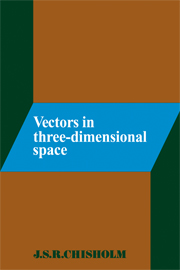Book contents
- Frontmatter
- Contents
- Preface
- 1 Linear spaces and displacements
- 2 Scalar products and components
- 3 Other products of vectors
- 4 Transformations of vectors
- 5 Curves and surfaces; vector calculus
- 6 Vector analysis
- Appendix A Some properties of functions of two variables
- Appendix B Proof of Stokes' theorem
- Reference list
- Outline solutions to selected problems
- Index
Preface
Published online by Cambridge University Press: 28 January 2010
- Frontmatter
- Contents
- Preface
- 1 Linear spaces and displacements
- 2 Scalar products and components
- 3 Other products of vectors
- 4 Transformations of vectors
- 5 Curves and surfaces; vector calculus
- 6 Vector analysis
- Appendix A Some properties of functions of two variables
- Appendix B Proof of Stokes' theorem
- Reference list
- Outline solutions to selected problems
- Index
Summary
It is a fundamental fact of nature that the space we live in is threedimensional. Consequently, many branches of applied mathematics and theoretical physics are concerned with physical quantities defined in 3-space, as I shall call it; these subjects include Newtonian mechanics, fluid mechanics, theories of elasticity and plasticity, nonrelativistic quantum mechanics, and many parts of solid state physics. The Greek geometers made the first systematic investigation of the properties of ‘ordinary’ 3-space, and their work is known to us mainly through the books of Euclid; our basic geometrical ideas about the physical world have their origins in Euclidean geometry. A major advantage of Euclid's work was its presentation as a deductive system derived from a small number of definitions and axioms (or ‘basic assumptions’); although Euclid's axioms have turned out to be inadequate in a number of ways, he nevertheless provided us with a model of what a proper mathematical system should be [Reference p.i].
Through the introduction of coordinate systems, Descartes linked geometry with algebra [Reference P.2]; geometrical structures in 3-space such as lines, planes, circles, ellipses and spheres, were associated with algebraic equations involving three Cartesian coordinates (x, y, z). Then in the nineteenth century, Hamilton [Reference P.3] and Gibbs [Reference P.4] introduced two similar types of algebraic objects, ‘quaternions’ and ‘vectors’, which treated the three coordinates simultaneously; the rules of operation of these new sets of objects were different from those of real or complex numbers, giving rise to new types of ‘algebra’; a more general algebra of N-dimensional space (N = 3, 4, 5, …) was introduced by Grassmann [Reference P.5].
Information
- Type
- Chapter
- Information
- Vectors in Three-Dimensional Space , pp. vii - xiiPublisher: Cambridge University PressPrint publication year: 1978
